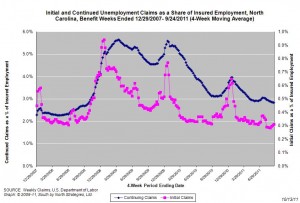13.10.2011
Policy Points
For the benefit week ending on September 24, 2011, some 13,702 North Carolinians filed initial claims for state unemployment insurance benefits, and 105,022 individuals applied for state-funded continuing benefits. Compared to the prior week, there were more initial and more continuing claims. These figures come from data released by the U.S. Department of Labor.
Averaging new and continuing claims over a four-week period — a process that helps adjust for seasonal fluctuations and better illustrates trends — shows that an average of 12,228 initial claims were filed over the previous four weeks, along with an average of 104,871 continuing claims. Compared to the previous four-week period, the average number of initial claims was higher, while the average number of continuing claims was lower.
One year ago, the four-week average for initial claims stood at 13,787 and the four-week average of continuing claims equaled 117,870.
While the number of claims has dropped over the past year so has covered employment. Last week, covered employment totaled 3.7 million, down from 3.8 million a year ago.
 The graph shows the changes in unemployment insurance claims (as a share of covered employment) in North Carolina since the recession’s start in December 2007.
The graph shows the changes in unemployment insurance claims (as a share of covered employment) in North Carolina since the recession’s start in December 2007.
Both new and continuing claims appear to have peaked for this cycle, and the four-week averages of new and continuing claims have fallen considerably. Yet continuing claims remain at an elevated level, which suggests that unemployed individuals are finding it difficult to find new positions.
13.10.2011
Policy Points
From the Economic Policy Institute’s analysis of the August version of the Job Openings and Labor Turnover Survey (JOLTS) …
… August marks three years straight that the job seeker’s ratio has been at or above 3-to-1. Put another way: we’ve exceeded the highest level reached in the early 2000s recession for the last three years straight. And we’ve been substantially above 4-to-1 for the last two years and eight months. A job seeker’s ratio of more than 4-to-1 means that for more than three out of four unemployed workers, there simply are no jobs. Two years and eight months—139 weeks—of a job seeker’s ratio above 4-to-1 is why the current extended unemployment insurance benefits, which last a maximum of 99 weeks, remain crucial. Furthermore, extending these benefits will not contribute to keeping the unemployment rate high, as some economists have claimed.
12.10.2011
Policy Points
Economic policy reports, blog postings, and media stories of interest:
12.10.2011
Policy Points
Free Exchange thinks about what makes a job “green” and how “green jobs” should be counted.
How to define green jobs may not seem like a pressing concern, but it does matter, because the parameters of the population determine its observable characteristics. That in turn will impact our views about green jobs and our interest, or lack thereof, in trying to create them. So let’s look around. The Bureau of Labour Statistics actually has two definitions, one based on output and one based on process. The output criterion includes establishments that actually create products with environmental benefits. At the wastewater facility, for example, all the jobs are green. The process category is broader and will count workers who complete environmentally helpful tasks at establishments that are not necessarily classed as green overall—so, for example, the guy at Dupont who tests the water has a green job. Having two definitions may seem confusing, but it it’s good to acknowledge ambiguity where it is known to exist.
…
Other outfits, however, want to pin it down. But their estimates vary widely.
The post concludes as follows:
This points to an interesting conclusion. Environmentalists sometimes exaggerate the size of the green economy. This is, presumably, because it makes the sector seem more important to the economy as a whole. But as we see with the growth in rewnewables, the numbers may be more compelling when you winnow it down to the categories of strength. And for advocates, the broader definitions may actually be counterproductive. People find obvious exaggerations unconvincing, even offensive. It may be unfair to the environmental crowd that they’re being hammered by the spectacular failure of Solyndra. But it was unfair to the taxpayers that politicians were pushing that company so hard. People may have a greater tolerance for uncertainty than politicians think. If politicians want to create “green jobs”—and whether they should try to do so is another question—candour is better than hype. More sustainable that way.
12.10.2011
Policy Points
Mike Konczal points out that a “lost decade” for jobs is built one month at a time.
… many continue to argue whether this month was good or that month was off. But stepping back, it looks to have been a lost year since last September [2010]. In general, we are below the number of jobs our economy can produce, leaving millions unemployed and unproductive. We are treading water with no hopes of serious moves in fiscal, monetary, and housing policies that could kick the economy and get it moving again. When we wonder how a lost decade can pass, remember that a decade is just a series of months one after the other, a series of months where it’s never quite bad enough to jolt action, compiled into years that are tossed down the drain.
 The graph shows the changes in unemployment insurance claims (as a share of covered employment) in North Carolina since the recession’s start in December 2007.
The graph shows the changes in unemployment insurance claims (as a share of covered employment) in North Carolina since the recession’s start in December 2007.
 Email Sign-Up
Email Sign-Up RSS Feed
RSS Feed